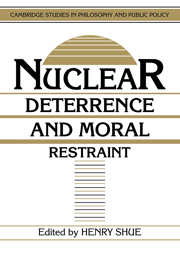Book contents
- Frontmatter
- Contents
- Preface
- Notes on contributors
- Introduction
- 1 Having it both ways: the gradual wrong turn in American strategy
- 2 Finite counterforce
- 3 Deterrence and the moral use of nuclear weapons
- 4 Escaping from the bomb: immoral deterrence and the problem of extrication
- 5 The necessary moral hypocriy of the slide into mutual assured destruction
- 6 Finite deterrence
- 7 Defending Europe: toward a stable conventional deterrent
- 8 The case for deploying strategic defenses
- 9 Morality, the SDI, and limited nuclear war
- Index
3 - Deterrence and the moral use of nuclear weapons
Published online by Cambridge University Press: 26 January 2010
- Frontmatter
- Contents
- Preface
- Notes on contributors
- Introduction
- 1 Having it both ways: the gradual wrong turn in American strategy
- 2 Finite counterforce
- 3 Deterrence and the moral use of nuclear weapons
- 4 Escaping from the bomb: immoral deterrence and the problem of extrication
- 5 The necessary moral hypocriy of the slide into mutual assured destruction
- 6 Finite deterrence
- 7 Defending Europe: toward a stable conventional deterrent
- 8 The case for deploying strategic defenses
- 9 Morality, the SDI, and limited nuclear war
- Index
Summary
A fundamental underlying assumption of America's nuclear deterrence doctrine throughout its evolution over the past forty years is that deterrence is a function of both capability and resolve. For nuclear deterrence to work, it is held, the United States must not only have the capability to make nuclear warfare “a totally unacceptable and unrewarding proposition for the Soviet leadership”: U.S. leaders must also be perceived as willing to inflict unacceptable nuclear destruction on the Soviet Union in response to a Soviet nuclear attack on the United States or its allies. This assumption about the critical role of resolve in deterrence lies behind the concern for “credible” response options so prevalent in U.S. strategic nuclear doctrine and was a major motivating factor in the development of America's “countervailing” nuclear warfighting strategy, adopted in 1979 and reaffirmed by the Reagan Administration.
The familiar logic of the countervailing strategy is that for deterrence to work the United States needs, first of all, the capability to destroy “those assets which are essential to Soviet warmaking capability and political control” (such as strategic and general-purpose forces, hardened command and control centers, and leadership cadres) because this is what Soviet leaders value most – not the general Soviet population and civilian economy. But, to make nuclear threats credible, the United States also needs the capability to minimize damage in a nuclear war to itself and its allies primarily through options for limited, controlled counter–military/political attacks (“to defeat Soviet military objectives without necessarily triggering a massive nuclear exchange”) but also through civil defenses (to provide some limited protection for the U.S. population).
- Type
- Chapter
- Information
- Nuclear Deterrence and Moral RestraintCritical Choices for American Strategy, pp. 115 - 162Publisher: Cambridge University PressPrint publication year: 1989



